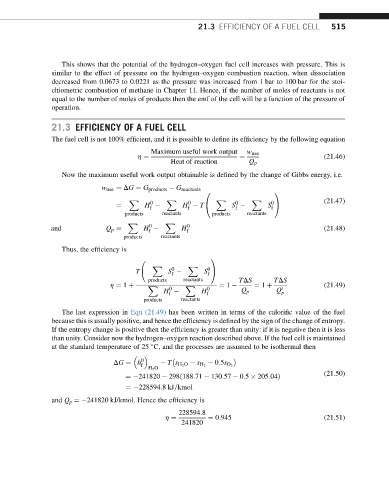Page 522 - Advanced thermodynamics for engineers
P. 522
21.3 EFFICIENCY OF A FUEL CELL 515
This shows that the potential of the hydrogen–oxygen fuel cell increases with pressure. This is
similar to the effect of pressure on the hydrogen–oxygen combustion reaction, when dissociation
decreased from 0.0673 to 0.0221 as the pressure was increased from 1 bar to 100 bar for the stoi-
chiometric combustion of methane in Chapter 11. Hence, if the number of moles of reactants is not
equal to the number of moles of products then the emf of the cell will be a function of the pressure of
operation.
21.3 EFFICIENCY OF A FUEL CELL
The fuel cell is not 100% efficient, and it is possible to define its efficiency by the following equation
Maximum useful work output w use
h ¼ ¼ (21.46)
Heat of reaction Q p
Now the maximum useful work output obtainable is defined by the change of Gibbs energy, i.e.
w use ¼ DG ¼ G products G reactants
0 1
0 0 0
X X X X (21.47)
¼ H H T @ S S f 0 A
f
f
f
products reactants products reactants
X 0 X 0
and Q p ¼ H H f (21.48)
f
products reactants
Thus, the efficiency is
1
X 0 X
T S S f 0 A
f
products reactants TDS TDS
h ¼ 1 þ X 0 X 0 ¼ 1 ¼ 1 þ (21.49)
H H f Q p Q 0 p
f
products reactants
The last expression in Eqn (21.49) has been written in terms of the calorific value of the fuel
because this is usually positive, and hence the efficiency is defined by the sign of the change of entropy.
If the entropy change is positive then the efficiency is greater than unity: if it is negative then it is less
than unity. Consider now the hydrogen–oxygen reaction described above. If the fuel cell is maintained
at the standard temperature of 25 C, and the processes are assumed to be isothermal then
DG ¼ h 0 f T s H 2 O s H 2 0:5s O 2
H 2 O
(21.50)
¼ 241820 298ð188:71 130:57 0:5 205:04Þ
¼ 228594:8kJ=kmol
and Q p ¼ 241820 kJ/kmol. Hence the efficiency is
228594:8
h ¼ ¼ 0:945 (21.51)
241820

